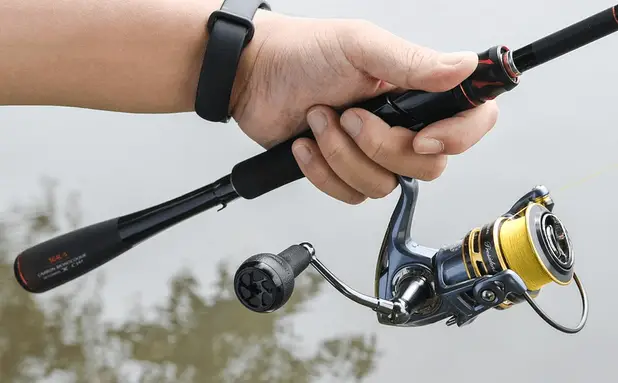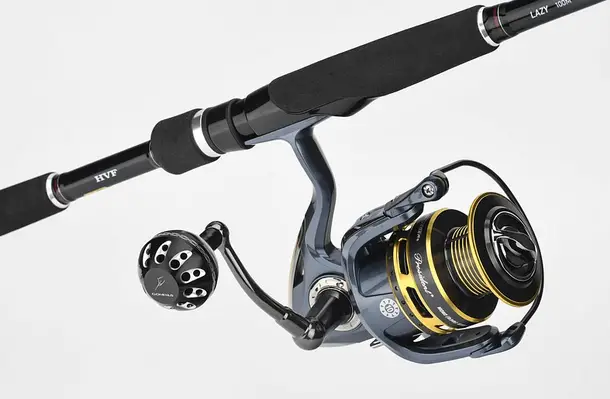Learn how to use a spinning reel with the help of my lesson. This step by step guide is very simple and helpful-
To use a spinning reel, open the bail, tie your lure, and cast by flipping the bail shut after releasing the line. Reel in by turning the handle smoothly.
Anglers favor spinning reels for their creativity and ease of use, whether they’re novices or seasoned fishermen. This must-have fishing tool helps you cast lines with precision and retrieve catches effectively. Mastering the spinning reel can significantly enhance your fishing experience, making it a skill worth acquiring.
Understanding the basics of threading your line, setting the drag, and maintaining proper reel balance is important. The key is in the details: properly spooling the line prevents twists and knots, while the right casting technique increases accuracy. This tips will lead to more successful fishing trips and a more enjoyable time on the water. With practice, using a spinning reel becomes second nature, Enables anglers to focus on the thrill of the catch.
The Spinning Reel Advantage
Excitement builds at the water’s edge. Anglers with spinning reels are ready. These reels offer a blend of simplicity and versatility hard to match. Paired with the right techniques, they promise an unmatched fishing experience.
Why Anglers Choose Spinning Reels
Spinning reels win favor for good reason. Beginners love them for their ease of use. Professionals value the precise control.
- Easy to cast – flip the bail, aim, and let it fly.
- Lightweight lures work well.
- Tangle issues? Much less than other types.
- Adjustable drag system – fight fish effectively.
Key Differences From Other Reel Types
Let’s dive into what sets spinning reels apart.
| Feature | Spinning Reel | Other Reels |
| Casting Mechanism | Fixed spool | Moving spool |
| Line Twist | Less common | More common |
| Weight | Lighter | Varies |
| Lure Size | Smaller | Larger |
The difference lies in the design. The spinning reel’s fixed spool means easy casting. Lines flow freely with fewer tangles. The weight balance allows for all-day fishing without fatigue.
Getting To Know Your Spinning Reel
Before you cast your line into the water, take a moment to connect with the tool in your hands. A spinning reel is a faithful companion for any angler, and understanding its parts and quality is key to mastering its use. Let’s dive into the anatomy of your spinning reel and explore what materials help make a reel reliable and efficient.
Anatomy Of A Spinning Reel
Knowing each part of your spinning reel boosts your fishing game. Imagine it as a puzzle, where every piece needs to work in harmony. Here’s a breakdown:
- Handle: Turn this to wind the line back onto the spool.
- Spool: This holds your fishing line.
- Bail: It guides the line onto the spool as you reel in.
- Drag Knob: It lets you set the line’s resistance against a pulling fish.
- Line Roller: This guides the line to and from the spool smoothly.
- Body: The reel’s main structure, often made of durable materials.
Material And Build: What To Look For
The strength and weight of a spinning reel depend on its material and build. Select a reel that promises endurance and ease of use. Here’s what to consider:
| Material | Benefits |
| Aluminum | Durable and strong, resists corrosion. |
| Graphite | Lighter weight, good for longer fishing trips. |
| Stainless Steel | Sturdy and holds up in saltwater. |
Check the build quality. Ensure that parts fit tightly with no loose screws. A well-constructed reel will perform better and last longer.
Setting Up Your Spinning Reel
Setting Up Your Spinning Reel is a crucial step before you head to the waters. Whether a seasoned angler or a beginner, a properly set-up reel enhances your fishing experience. A spinning reel, known for its versatility and ease of use, demands attention during setup. Let’s master the basics in two key steps: attaching the reel to a rod, and spooling line onto the reel.
Attaching The Reel To A Rod
First, ensure you have the right rod for your reel. Compatibility between rod and reel dictates balance and comfort while fishing. Follow these steps:
- Open the bail on the reel by lifting the wire arm.
- Place the reel foot into the slot on the rod handle.
- Secure the reel by tightening the reel seat. Make sure it’s firmly in place.
This simple attachment can make or break your fishing success.
Spooling Line Onto The Reel
Correct line spooling prevents tangles and line twist. Follow these steps:
- Open the bail arm to ready the reel for spooling.
- Run the line through the first rod guide, towards the reel.
- Tie the line to the reel spool with an arbor knot.
- Trim any excess line from the knot.
- Close the bail manually.
- Apply light pressure to the line with your fingers as you reel slowly.
| Line Type | Recommended Tension |
| Monofilament | Light to Medium |
| Braided | Medium to Tight |
Spool until the line is 1/8 inch from the rim of the spool.
Mastering The Cast
Mastering the cast with a spinning reel is a skill that elevates your fishing game. It’s not just about tossing your line into the water. It’s a nuanced art form, pairing precision with the right technique to land your bait exactly where you want it. Whether you’re a beginner or looking to refine your skills, these tips will guide you to casting mastery.
The Basics Of Casting A Spinning Reel
Start with the right stance: Feet shoulder-width apart offers stability. Hold the rod comfortably, with the reel below the rod, and your dominant hand on the rod handle. Your other hand should open and close the bail.
Reel in: The bait or lure should hang 6 to 12 inches from the rod tip. This distance ensures optimal control during the cast.
Opening the bail: With your index finger, flip the bail arm up. This action frees the line for casting.
Holding the line: Place your index finger against the rod to hold the line. This grip is crucial for control.
Making the cast: Bring the rod back over your shoulder, then swing it forward quickly. Release the line by lifting your index finger at the right moment. The lure should fly towards your target area.
Advanced Casting Techniques
Overhead cast: This is the most common. Start with the rod behind your head and whip it forward in a smooth motion, releasing the line at eye level.
Sidearm cast: Ideal for tight spaces. Swing the rod horizontally from your side, releasing the line parallel to the water.
Pitching: Good for short distances. Hold the lure in your hand, lower the rod tip, and flick the lure underhand while releasing the line.
Underhand cast: This is a discreet method, perfect for sneaky casts. Drop the lure a little lower and gently toss it underhand while releasing the line with your finger.
Practice makes perfect: Use targets for practice. With each technique, focus on aim and smooth line release.
Maintaining Your Spinning Reel
Maintaining your spinning reel is crucial for its longevity and performance. Just like any piece of machinery, a spinning reel benefits from regular care. Let’s dive into the steps for keeping your reel in top condition.
Routine Cleaning And Lubrication
Clean reels catch more fish. Dirt and sand can harm your reel. Follow these steps to keep it clean:
- Use a soft cloth to wipe down the reel after each use.
- Remove the spool and clean underneath with a gentle brush.
- Check for line tangles and damage.
- Apply oil to moving parts twice a year.
- Use grease on gears yearly for smooth action.
Regular oiling and greasing prevent rust and wear. Your reel will work like new with these simple habits.
Tips For Successful Fishing With Spinning Reel
Embarking on a fishing adventure with a spinning reel opens up a world of excitement. But to ensure success, it’s crucial to know the right tactics. This guide provides expert tips that can transform a novice into a skilled angler. Learn to master your spinning reel and reel in the big catch every time.
Secrets For Lure And Bait Selection
Match the Hatch: Observe the natural prey in the area. Select lures that mimic the size, shape, and color of these creatures.
| Fish Type | Lure Type | Color Choice |
| Bass | Crankbaits | Green or Brown |
| Trout | Spinners | Silver or Gold |
| Pike | Soft Plastics | Red or Yellow |
Consider Water Temperature: Fish metabolism changes with water temperature. Use slow-moving baits in colder water and more active ones when it’s warmer.
- Cold Water: Jigs and plastic worms work well.
- Warm Water: Switch to topwater lures and crankbaits.
Experiment and Take Notes: Keeping a record of what works can guide your future bait choices. Note the conditions, lures types, and fish response for future reference.
How To Use a Spinning Reel for Beginners
FAQ
How Do You Use A Spinner Fishing Reel?
Open the bail on the reel, hold the line with your index finger, cast the lure by swinging the rod forward, release the line at the peak of your cast, then close the bail and reel in slowly, imparting action to the lure as it moves through the water.
Are Spinning Reels Easy To Use?
Yes, spinning reels are user-friendly, making them ideal for both novice and experienced anglers. Their simple design allows for easy casting and retrieval.
When Should You Use A Spinning Reel?
Use a spinning reel for light bait and tackle, providing accurate casts with smaller lures and finesse fishing techniques. Ideal for beginners, it excels in freshwater and inshore saltwater fishing.
Last Word
Mastering the use of a spinning reel boosts your fishing game, offering precision and ease. By perfecting the techniques discussed, you’ll enjoy more successful outings and a stronger connection with the sport. Keep practicing, stay patient, and let every cast bring you closer to the catch of the day.
Tight lines and happy fishing!


